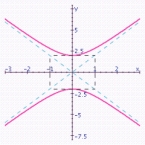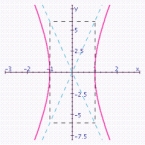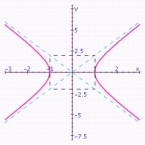Graph the hyperbola. Specify the following: vertices, foci, lengths of transverse and conjugate axes, eccentricity, and equations of the asymptotes.
A)  vertices: ;
vertices: ;
Foci: ;
Length of transverse axis: 4;
Length of conjugate axis: 2;
Eccentricity:
Asymptotes: .
B)  vertices: ;
vertices: ;
Foci: ;
Length of transverse axis: 2;
Length of conjugate axis: 4;
Eccentricity: ;
Asymptotes: .
C)  vertices: ;
vertices: ;
Foci: ;
Length of transverse axis: 4;
Length of conjugate axis: 2;
Eccentricity:
Asymptotes: .
D)  vertices: ;
vertices: ;
Foci: ;
Length of transverse axis: 2;
Length of conjugate axis: 12;
Eccentricity: ;
Asymptotes: .
E)  vertices: ;
vertices: ;
Foci: ;
Length of transverse axis: 2;
Length of conjugate axis: 4;
Eccentricity: Asymptotes: .
Correct Answer:
Verified
Q13: The point Q14: Graph the ellipse. Specify the lengths Q15: Find the equation of the tangent Q16: Graph the hyperbola. Specify the following: Q17: Find the center and the radius Q19: Use the given information to find Q20: Graph the ellipse. Specify the lengths Q21: An angle of rotation is specified, Q22: Select the graph that represents the Q23: Find
Unlock this Answer For Free Now!
View this answer and more for free by performing one of the following actions

Scan the QR code to install the App and get 2 free unlocks

Unlock quizzes for free by uploading documents